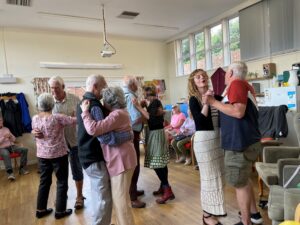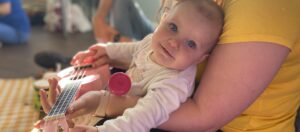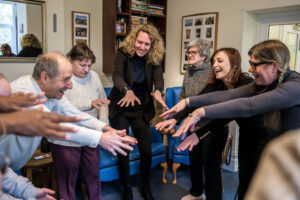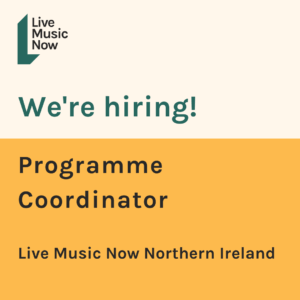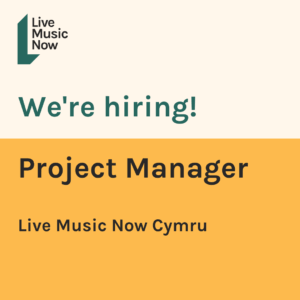On 8 May, LMN cellist Beatrice Newman and harpist Bethan Semmens visited the Royal United Hospital in Bath. Our Executive Director Evan Dawson went along to see them in action, and to meet the people behind the arts programme there (entitled 'Art at the Heart').

To start with, Beatrice and Bethan gave a performance in the large public atrium in the hospital, where people gather to wait for their appointments (as part of their 'Soundbit Lunchtime' series). This is a hospital where there is a particular specialism for cancer treatment, and those waiting are often in a very delicate emotional condition. It is a very pleasing space, with colourful artworks, and a well-run cafe. There were about 150 people there.
The performance transformed the atmosphere, as the sounds of medical equipment and subdued conversation were replaced with uplifting and virtuosic playing. It gave the space a focal point too. I found myself making eye contact with others who were listening, and there was an immediate sense of a collective experience, particularly when clapping between pieces. People in wheelchairs were brought closer, and ambulance staff and doctors came over too. I was in no doubt that the music made a lot of people happy and more relaxed, with something new to discuss together.
After their time in the atrium, we were taken upstairs to the wards. These were all geriatric wards, in which people were mostly lying in bed, in ‘bays’ of six or eight beds. There were a large number of doctors and nurses there, but mostly the atmosphere was very subdued, with the soft sounds of medical equipment punctuated by human sounds. It was light, clean and pleasant, but (by necessity) it wasn’t ‘homely’. Wards such as this are ‘closed’, and seem to be quite similar to many care homes in the care they provide for people living with more advanced dementia, or who are near the ends of their lives.

In each of the ‘bays’, we were accompanied by a staff member, who helped Bethan and Beatrice set up in a central spot where everyone could see them. They spoke to each patient in turn, to introduce themselves, and ask if they had any musical suggestions. In some cases, people didn’t respond, and one even shouted “rubbish!” throughout; but most people were clearly uplifted by the experience. Bethan and Beatrice joked with many, feet tapped, and people sang along. They applauded, and laughed with each other and with staff and carers, who all gathered at the entrances to the bays as the music started.
One of the things that surprised me was how very respectful everyone was. Doctors and nurses clearly didn’t consider the music to be an inconvenience, but a great asset. One lady had some blood taken during a performance, and was clearly not troubled by it all, which was apparently quite unusual. When we left, I felt that people had made a real connection with each other, and smiles had replaced lethargy for a period.
I spoke at length with Hetty Dupays, who is the hospital’s Arts Programme Manager. She told me that the hospital really believes in the power of the arts to enhance the patient experience, and to deliver real measurable benefits to patients. This could be a simple matter of helping people feel relaxed; or comfortable to enter into medical spaces, which can often be daunting or stressful. It can also be more specific, contributing to reduced recovery times, willingness to take medicines or food, or the morale of staff. A happy and creative hospital is far more likely to be effective at curing people.
I also spoke to Andrew Fletcher, whose mother’s trust has long supported both LMN and the arts programme at the hospital.
He told me: “I have had a great admiration for Hetty's dedication and personal skill with the RUH Arts organisation for many years. Her various assistants (from Bath Spa Uni and elsewhere) have been all been great musicians and administrators; some of the best are now pursuing music & health well-being at post-graduate levels.”
He went on to say, “I was drawn to LMN through its dual objectives, supporting musicians in their early careers and providing music in venues where people are largely confined to the premises. The benefits to these people always seemed considerable, and this is increasingly being backed up by research.”
Finally, I spoke with Bethan and Beatrice themselves.
Bethan said, “In the same way as we would approach concerts at care homes, we aim to have a wide variety of music to cater for as many tastes as possible. Something that became very apparent during our last hospital session was the need for us as musicians to feel empathy for the patients. Some may feel like listening to live music at that specific time, where others may not – we then have to find a way of pleasing the patients who are interested with as little disturbance as possible to those who aren't feeling very well or whom are tired. In a care home all residents can choose whether they want to stay for the performance or leave, this isn't always possible on a hospital ward. During the past few years I have seen the effect live music has on residents at a care home and patients in hospitals and noticed that it encourages conversation, creates a calm atmosphere at times, triggers memories, makes people smile and is a great way of including the elderly population in the community.
Working for LMN has been invaluable experience at the beginning of my career, not only have I continued to expand my repertoire and improve my playing my confidence has developed greatly especially when conversing with others. Each performance is different so it’s necessary to be thinking on your toes about how to deal with a situation or how to answer questions from residents or even how to deal with an elderly lady desperately crying, wanting somebody but she doesn't know who or why. More and more confidence is gained with each performance and lessons are learned in every concert.”
And Beatrice said, “Our approach to working in hospitals varies depending on the age range and condition of the patients. Usually, patients are glad to have us come to their bedside and play – but we have to accept that sometimes they would prefer peace and quiet! In care homes – the residents are aware that we are coming to do a concert and can come and go as they please.
We believe that it does make a difference to the patients to be able to see and hear something different other than machines and medicine, especially if they are in hospital for a long time. It's rewarding for us to be able to make a change to the patients’ day and we hope that they can benefit from this scheme as well.”

